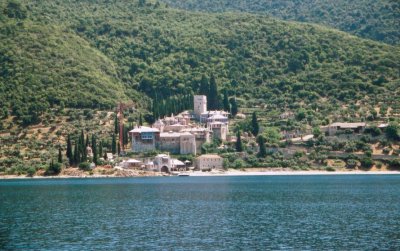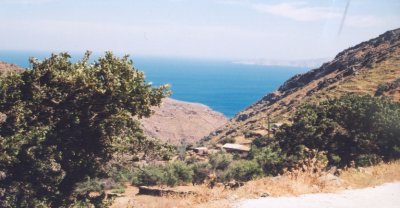FEATURE by Willard Manus
NISYROS, GREECE -- As health resorts go, Loutra will never achieve the world-wide fame of such glamorous German spas as Carlsbad or Baden-Baden. Nor will it ever give the USA's Hot Springs, Arkansas a run for its money. Yet if I had my druthers, I'd rather "take the waters" in quaint, little-known Loutra any day.
Located on
the flyspeck Greek island of Nisyros (located just south of Kos in the
eastern Aegean), Loutra sits on a seaside site two miles outside the main
town of Mandraki. The resort's main building, a two-story, 60-room stone
structure, was built in 1890; the only thing that's been changed since
then is the sheets.

Loutra is a throwback to another age and lifestyle. It's got creaky wooden
floors, bedrooms with more height than width, communal toilets and showers,
bare lightbulbs for illumination. Yet the atmosphere is anything but grim
and depressing. The rooms are kept spotlessly clean, the halls are flooded
by sunlight and cooled by seabreezes, and everything is imbued with an
air of tranquility and forbearance.
Loutra is actually famous in its own right. As a spa it dates back to Roman times. Hippocrates recommended Loutra's health-restoring mineral waters to his patients and made many a sojourn to the island himself. Thanks to its volcanic nature, Nisyros (like Santorini and Milos) seethes internally with geo-thermal heat and gases. The sulphurous waters created by this inferno may not be drinkable, but they have therapuetic properties which are like manna to those suffering from orthopedic and neuralgic problems.
In bygone
years Nisyros had three working spas, but the ones at Palli and Avli fell
into disuse. An attempt was made in 1940 to restore the resort and baths
at Palli when a wealthy Nysirian emigre returned from the Belgian Congo
and sunk a wad of money into what was intended as a deluxe 800-bed spa.
But the Second World War intervened and made completion of the project
impossible. Today the building stands abandoned and ruined, its gaping
windows and doors showing what might have been--grand suites, marble staircases
and baths, a grand dining room. Rumor has it that the Greek government
might provide the funds to revive the construction effort; meanwhile,
the damp, ghostly spa is occupied only by an occasional backpacker in
summer.

The Loutra spa is owned and operated by the demos, the civic administration
of Nisyros. We paid the E.U. equivalent of fifteen dollars a night for
our double-room, which overlooked a tiny harbor and the glistening, swiftly
running sea. The tariff included a consultation with the doctor who ran
the medical side of things, (depending on room availability, it's possible
to stay at Loutra without being obliged to take the waters).
When he ascertained that I was seeking relief from the lingering effects of a severe sciatic attack, he proscribed fifteen minutes of hot baths a day. (I paid an extra ten dollars a session for this treatment). Most of the other patients immersed themselves in the near-boiling volcanic waters for as long as half an hour daily. Not even those severely crippled by arthritis or rhuematism were allowed longer spells than that, lest they come out looking like poached eggs.
Each of us had a private bath, a large marble sit-down basin. ("Not as comfortable and colorful as the copper tubs of old," remarked one octogenarian). An attendant was on the scene, as well as a physio-therapist who provided massage and manipulation when necessary. Most of the patients were Loutra regulars who came every year for the baths, residing anywhere from two weeks to a month.
"The baths give you relief from your aches and pains, but are not a cure," said Dimitri, a retired policeman from Rhodes. "I've got arthritis in my hip, back and hands. By the time I leave Loutra after a few weeks of treatment, I'm free of pain. Then, over the winter, my condition starts to worsen. By the time I make it back here in summer, I'm crippled up and the cycle starts all over again."
My ails were not as serious as Dimitri's; all it took was three days of baths for the remnants of my sciatica to disappear.
Ninety per cent of the people who come to Loutra are Greeks, estimated the hotel's manager, Michael Mouras, with the remaining numbers coming from abroad. Just about everyone on staff, however, spoke English--including the doctor.
The hotel itself did not serve food, but there was a taverna next door run by Kyria Katina, who cooked fresh fish every day in addition to such specialties as chickpea cakes, hare and patridge. It was especially pleasant to sit over an ouzou and a plate of sakkouliasti (a crumbly white local cheese) at Katina's in the early evening and watch one of Nisyros' famed sunsets.
Many of the guests at Loutra had difficulty in walking and consequently did not stray far off the grounds. But for those who were mobile, the island offered a range of things to do. One could walk into Mandraki after lunch, when the baths were closed (everyone, from the doctor down, believed it was unhealthy to take the waters after mid-day as the therapy opened your pores and made you susceptible to cool breezes). Mandraki is a compact and charming town dominated by the towering, dramatic-looking monastery of Panagia Spiliana. Lots of tavernas, cafes, leafy squares and a bakery famous for its hot tiropitas (cheese pies).
Or one could take a taxi or bus up to Polyvotis, in the hills at the center of the island where the caldera is a tourist attraction. The caldera, essentially a gigantic hole in the ground, is all that remains of the volcano which blew its top eons ago and separated Nisyros from Kos. The deep holes and fissures in the yellowish soil leak sulphuric steam that smells like rotten eggs. The waters bubbling beneath the craters run down to Loutra in deep underground streams.
These mineral-rich streams provide sustenance to the fruit and vegetables grown on the island. So luscious and delicious are the local figs that the Turks, who occupied Nisyros between 1523 and 182l, called it Intzirli Antasi--Fig Island.
Nisyros is also famous for a drink called soumada (almond syrup and water).
There are only three other villages on the island, two of them perched high up in the mountains (Nikia and Emporios), the other (the fishing village of Palli) situated on the east coast and bustling with tavernas and pensions.
South of Palli there is mile upon mile of wild beachfront where it is possible to go bottomless as well as topless. Many naturists set up tents here and spend carefree--and clothesfree--holidays at the edge of the sea. One must have a car or motorbike, however, to be able to connect with civilization: shopping, post office, restaurants, nightlife.
Despite its small size and population (a thousand inhabitants), the town of Mandraki is hyper-active and noisy (motorbike heaven). There are only three relatively large hotels, the Porfirus, The Three Brothers and the Romantso, but small pensions and studio apartments abound, with more being built every day now that mass tourism is beginning to find its way to the island. One of the kingpins of Nisyros is Dimitri Hartofilis, whose Nisorama Tours (0242-3110, fax 0242-31254) can book rooms and trips, arrange motorbike rentals, etc.
Mandraki has several discos and innumerable bars which pump out music all night long. The singles scene isn't on the bigtime level of, say, Mykonos and Rhodes, but party animals will find plenty to do nonetheless.
Not in Loutra, though. Not only are there no bars or discos within earshot, this sign is posted prominently in the hotel lobby: "We Expect Peace and Quiet 24 Hours a Day."
Any wonder why Loutra is our favorite place to stay in all of Greece?
